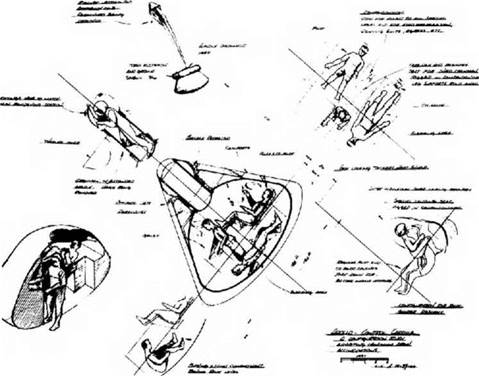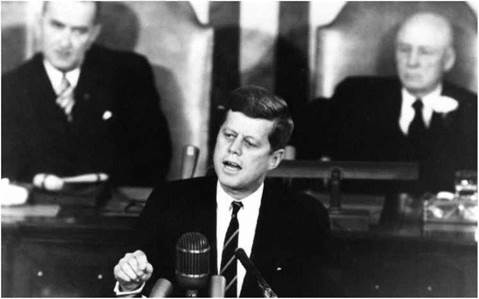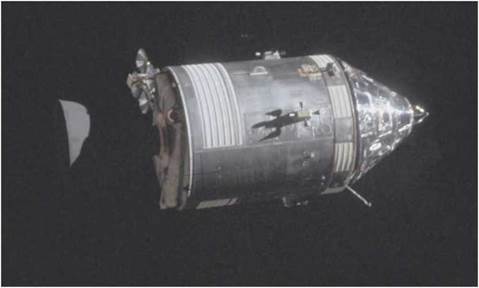DREAMING ОГ HIE MOON
In the years after World War II. in the bowels of America’s aeronautical research facilities, a few remarkably gifted engineers were having ideas above their station. Thinking outside the box. as we now call it, they wondered how a manned spacecraft (women were never considered) that had been blasted outside Earth’s atmosphere, could possibly return without killing its crew. Two in particular, Max Fagct and Owen Maynard, were formulating a plan to bring together diverse technologies that were then maturing which might allow the dream of space travel to be realised. Many of these technologies were also concerned with the delivery of nuclear weaponry – the most prominent examples being the liquid-fuelled rocket, the ablative heatshield and the blunt-body re-entry vehicle.
Both the USA and the Soviet Union had been familiarising themselves with rocket technology gleaned from the defeated Germans of World War II. Having learned from rocket engineers who had worked for the Nazis, both superpowers had launched vehicles that had been either looted from central Europe or built locally on the basis of German experience. It soon became apparent that these rockets would be useful carriers for the newly developed nuclear warhead, able to dispatch these weapons across large distances in a short time. Both sides in the Cold War had nuclear armaments, and both realised that in the event of an exchange, early delivery of their warheads would be crucial to national survival.
Fast delivery of nuclear weapons required development of the intercontinental ballistic missile (ICBM) whose long, coasting flight could cross continents in half an hour. Though this class of missile was not required to go fast enough for orbital flight, much of its trajectory was spent in the vacuum of space and one of the chief problems encountered in this arrangement was dealing with the punishing heat the payload had to endure as it re-entered the atmosphere at hypersonic speeds.
After dispensing with solutions that tried to absorb the energy in a heat sink, engineers turned to the ablative heatshield. This was a layer of material on the outside of the warhead fabricated from materials that would ablate – that is, they would slowly char and burn away, carrying the heat and thereby protecting the bomb as it came hurtling back into the atmosphere. At the same time, the work of H. Julian Allen had shown that by forming the shape of a re-entering body into a blunt shield, the searing hot shockwave that always accompanied high-speed aerodynamics could be made to stand away from the fabric of the hull, and thus keep the hottest and most erosive gases clear of the vehicle.
Faget and Maynard investigated whether this technology could be arranged so that a person could sit inside the rocket’s payload instead of a warhead, enter space and return to Earth without being roasted, chilled, asphyxiated, crushed or drowned. An early implementation of their work was the one-man Mercury spacecraft, a relatively unsophisticated capsule that enabled America to log its first minutes and hours of manned space flight. Even before the first such flight was attempted, engineers had begun to consider the design of a successor that could sustain a three-
|
Sketches from October 1960 for the “Apollo-Control Capsule”. (NASA) |
|
President John F. Kennedy announces his lunar challenge to Congress on 25 May 1961. (NASA) " " |
man crew for an extended flight in space and make a controlled descent through the atmosphere to land on the ocean. Although there was no specific mission for such a spacecraft, the engineers were intrigued by the possibility that it might be able to fly to the Moon.
The name for this spacecraft, Apollo, was coined in mid-1960 by the Director of NASA’s Office of Space Flight Programs, Abe Silverstein, who delved into Greek mythology for inspiration. Apollo was the son of Zeus and had associations with Helios the Sun god. In Silverstein’s mind, the idea of Apollo riding across the face of the Sun seemed an appropriate metaphor for the grand sweep of the programme that such a spacecraft might be able to undertake.
In May 1961, America had hardly dipped its toe in space with the 15-minute flight of Alan Shepard, when President Kennedy proclaimed a mission for this nascent spacecraft by challenging his nation to send a man to the Moon and return him safely to his home planet, and to do so within the eight and a half years still remaining of the 1960s. Kennedy’s early months as President had been troubled by a succession of ‘space firsts’ achieved by the Soviet Union, particularly on 12 April 1961 when Yuri Gagarin became the first person to fly in space by making a single orbit of Earth. Further trouble with an aborted invasion of Soviet-backed Cuba made Kennedy seek something that would raise America’s profile around the world. Landing men on the Moon, a goal that people within NASA were already thinking about, and carrying it out to a deadline, seemed like an enterprise at which his country could excel. The Apollo system would be pressed into this role.
|
Apollo 14 CSM Kitty Hawk in orbit around the Moon photographed from the lunar module. The conical command module is on the right. The cylindrical service module forms the spacecraft’s bulk. (NASA) |













